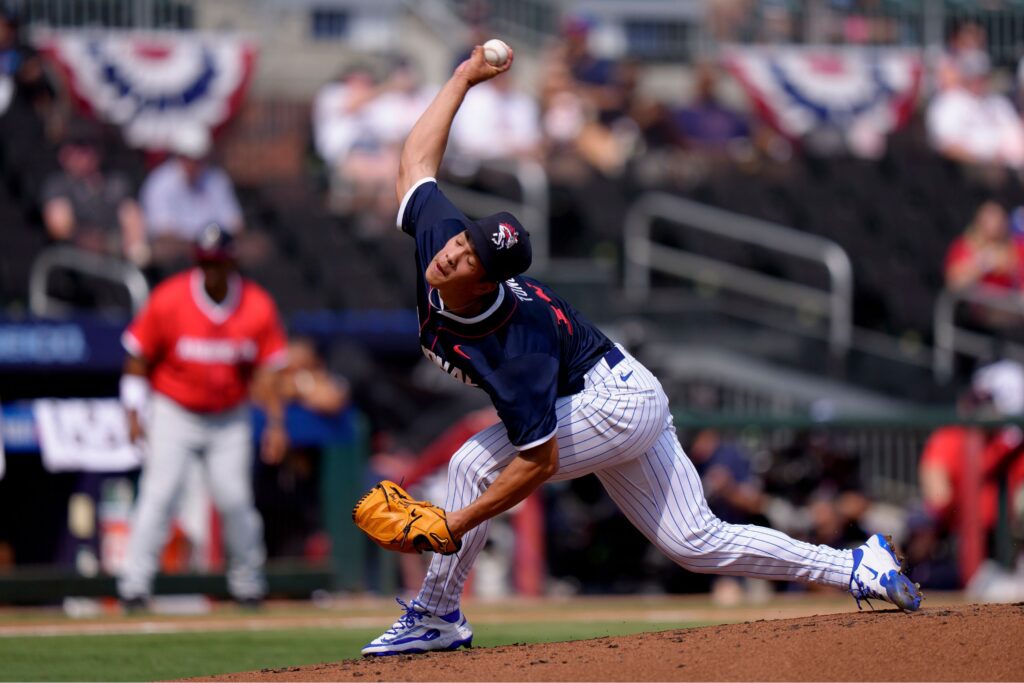Image credit:
Jonah Tong (Photo by Matt Dirksen/Getty Images)
The comparison was unavoidable.
When Mets pitching prospect Jonah Tong toed the rubber in the second inning of this year’s Futures Game in Atlanta, Jonathan Mayo on the MLB Network telecast evoked former Giants pitcher Tim Lincecum as a comparison point.
That was no coincidence. The 22-year-old Mets phenom models his pitching motion and approach off Lincecum, the two-time National League Cy Young Award winner in 2008 and ’09.
Tong spent most of this season at Double-A Binghamton, earning an August bump to Triple-A Syracuse, where he made two starts prior to his callup to the Mets to make his MLB debut on Aug. 29 against the Marlins.
Tong leads all minor league pitchers with 179 strikeouts, a 1.43 ERA and .148 opponent average.
As two smaller pitchers with unique looks on the mound, there are myriad similarities between Tong and Lincecum. But there are also a few key differences. Let’s see how they stack up against one another.
How They’re Similar
Pitching Mechanics
Tong uses a pitching motion similar to what Lincecum used, especially in the back of his delivery. Tong uses an exaggerated leg lift while rotating his torso backward toward second base, gathering all his power on his back leg. His glove arm sweeps up and out front, while in back he loads his right arm with a pronounced, deep motion.
Here is video of Tong’s appearance in the MLB Futures Game back in July courtesy of MLB Network:
As you can see, Tong practically jumps at the batter with elite extension of nearly seven feet. As he whips his body forward, he tilts his torso dramatically to allow his arm to get into a straight overhand position for release. Tong’s takeaway, balance point and load are almost identical to Lincecum’s.
For comparison’s sake, here are some highlights from Lincecum’s dominant, 14-strikeout performance in Game 1 of the 2010 NLDS:
Minor League Dominance
As mentioned above, Tong led all minor league pitchers in ERA, strikeouts and opponent average this season. He also allowed the lowest slugging percentage and OPS. His 0.92 WHIP ranked second-lowest.
Lincecum, meanwhile, made just 13 minor league starts in parts of two seasons. He struck out 58 batters in 31.2 innings in his pro debut after being drafted in 2006. Assigned to Triple-A Fresno in 2007, he made just five starts before the Giants called him up. In his time at Triple-A, he struck out 46 batters in 31 innings. No pitcher with at least five Triple-A starts that season had a lower ERA than Lincecum (0.29) or a higher strikeout rate (40.4%).
Times have changed in the nearly 20 years between Tong’s time at Triple-A and Lincecum’s. Strikeout rates are much higher today. The Triple-A strikeout rate in 2025 is 22.6%. In 2007, it was 17.8%.
Lincecum’s 40.5% strikeout rate in 2007 was 22.6 percentage points higher than the Triple-A average. Tong’s 37.8% rate at Triple-A this year is 15.1 percentage points higher than average. At Double-A, it was 17.3 percentage points higher than the average for the level.
Lincecum wasn’t called “The Freak” for nothing. For a starter to strike out 40% of batters in 2007 was unheard of. His strikeout rate was literally more than twice the Triple-A average.
Smaller Stature, Big Velocity
“If Tim Lincecum wasn’t 5-foot-9 and 140 pounds, he might be (Washington) state’s best draft pick,” Baseball America wrote about Lincecum when he was a high school senior in 2003.
While concerns about physicality and durability would follow Lincecum throughout college and the minor leagues, he answered his doubters with a 10-year MLB career that included two Cy Young Awards, four all-star bids and three World Series rings with the Giants in 2010, 2012 and 2014.
Lincecum’s official height and weight in the MLB database is now recorded as 5-foot-11, 170 pounds, but as is the case with most pitchers, he is likely shorter than his listed height.
Lincecum averaged somewhere between 93 and 95 mph, depending on the source, when he reached the big leagues in 2007. Even on the low end of that range, Lincecum threw more than 2 mph harder than the average righthanded starter of his time. He topped out at 97.
In Tong’s two Triple-A starts this year for which we have Statcast data, he averaged 95.8 mph and topped out at 98. The MLB average velocity for a righthanded starter today is about 94.6 mph, meaning Tong is roughly 1 mph faster than average.
Tong is listed at 6-foot-1, 180 pounds and might be a touch shorter than that. He has leaner shoulders but appears to be more solidly built at age 22 than Lincecum ever was. Tong has a strong foundation, with apparent musculature in his thighs and lower half.
“He doesn’t miss leg day,” as one scout joked.
How They’re Different
Repertoire
While both Lincecum and Tong have high-velocity four-seam fastballs with good riding life, Tong’s fastball is a much more reliable whiff pitch than Lincecum’s was due to its outlier vertical break.
Tong’s top secondary pitch is a Vulcan-grip changeup he unveiled this season. It’s arguably his top pitch because of how well it plays off his fastball. Now, batters have to be ready to hit a mid-90s fastball—which is up several ticks from where Tong sat last season—only to risk seeing a mid-80s changeup with fade and tumble.
Tong throws his fastball or changeup about 85% of the time or more. It’s unusual for a righthanded starter to throw so few breaking pitches, but that’s not to say Tong lacks feel for spin.
He used his curveball to good effect at the Futures Game, striking out Mariners Top 100 Prospect Harry Ford swinging on full-count breaker below the zone. In fact, Tong’s Double-A pitching coach, Dan McKinney, is complimentary of his curveball.
“When he gets his curveball going, he can have a lot of success with it,” McKinney said this summer. “He generated quite a bit of whiff versus lefthanded hitters with it. It’s not a super high-usage pitch. He threw it more last year when his changeup was a lower-usage pitch. This year, his changeup has taken off, but I really like his curveball.”
By contrast, Lincecum was a more traditional righthanded starter in the sense that he mixed in breaking pitches about 20% of the time, upping that usage to 25-30% with two strikes. He also had a deadly splitter that gave him an offspeed out-pitch to pair with his curveball.
Track Record
When the Mets drafted Tong in the seventh round in 2022, little was known about him outside MLB scouting departments. He transferred from his high school in Ontario to Georgia Premier Academy in order to showcase for the draft.
Coming out of the pandemic, Canadian prospects struggled to be seen by scouts because of travel restrictions, and Tong was one of several to relocate to the United States. Fellow Mets prospect Calvin Ziegler is another example, as is Diamondbacks lefthander Mitch Bratt.
Marc Tramuta, the Mets’ scouting director in 2022 and now in that role with the Blue Jays, praised Tong’s fastball metrics, riding life and athletic delivery. Tong did not pitch the summer after being drafted and then missed most of 2023 with an injury before exploding onto the scene at Class A in 2024 and then continuing to dominate at Double-A this season.
Lincecum, on the other hand, was a known commodity since he was a teenager, years before he was drafted 10th overall out of Washington in 2006. That 2006 draft was one of the most pitching-rich drafts of all-time, as Clayton Kershaw, Max Scherzer and Lincecum were all first-rounders that year.
Already a prospect coming out of high school in 2003, Lincecum only enhanced his status in three years in the Pacific-10 Conference. In 2004, he was the first pitcher in Pac-10 history to win conference freshman of the year and pitcher of the year in the same season. In 2005, he continued to dominate—if not at the same level—and led the Cape Cod League in ERA as a reliever that summer. Cleveland drafted him in the 42nd round—in an era before bonus pool restrictions—but failed to meet his asking price. He returned to Washington for his junior year.
In 2006, Lincecum was again Pac-10 pitcher of the year with a since-broken conference record of 199 strikeouts. By the end of 2007, he was in the big leagues, having ranked as the No. 11 prospect in baseball heading into the season and claiming Best Pitching Prospect, Best Fastball and Best Breaking Pitch category wins in 2007 Pacific Coast League voting for BA Best Tools.
Delivery Out Front
“His unorthodox delivery has been described as resembling a pinwheel as he rocks back, makes his body do most of the work and seemingly brings his lightning-quick arm along for the ride,” BA wrote about Lincecum in his 2006 draft report.
There was nothing accidental about Lincecum’s pitching motion. His father helped him engineer his delivery to get the most out of his smaller frame and fast arm. His arm was live, whippy and loose, his delivery surprisingly dexterous.
Tong is more physical at age 22 than Lincecum was at the same age, but elements of Tong’s delivery out front appear more effortful. His dramatic trunk tilt and follow-through leave his head almost parallel to the ground at release.
Tong has been able to repeat his mechanics the last two minor league seasons, throwing 113 innings in both. His walk rates of 10% are on the high side—that figure ranks in 23rd percentile this season among minor leaguers with at least 100 innings.
It is notable that so few pitchers throw the ball quite the same way as Tong does. He is an outlier in almost every regard, just as Lincecum was as a prospect two decades ago.
Discover more from 6up.net
Subscribe to get the latest posts sent to your email.


